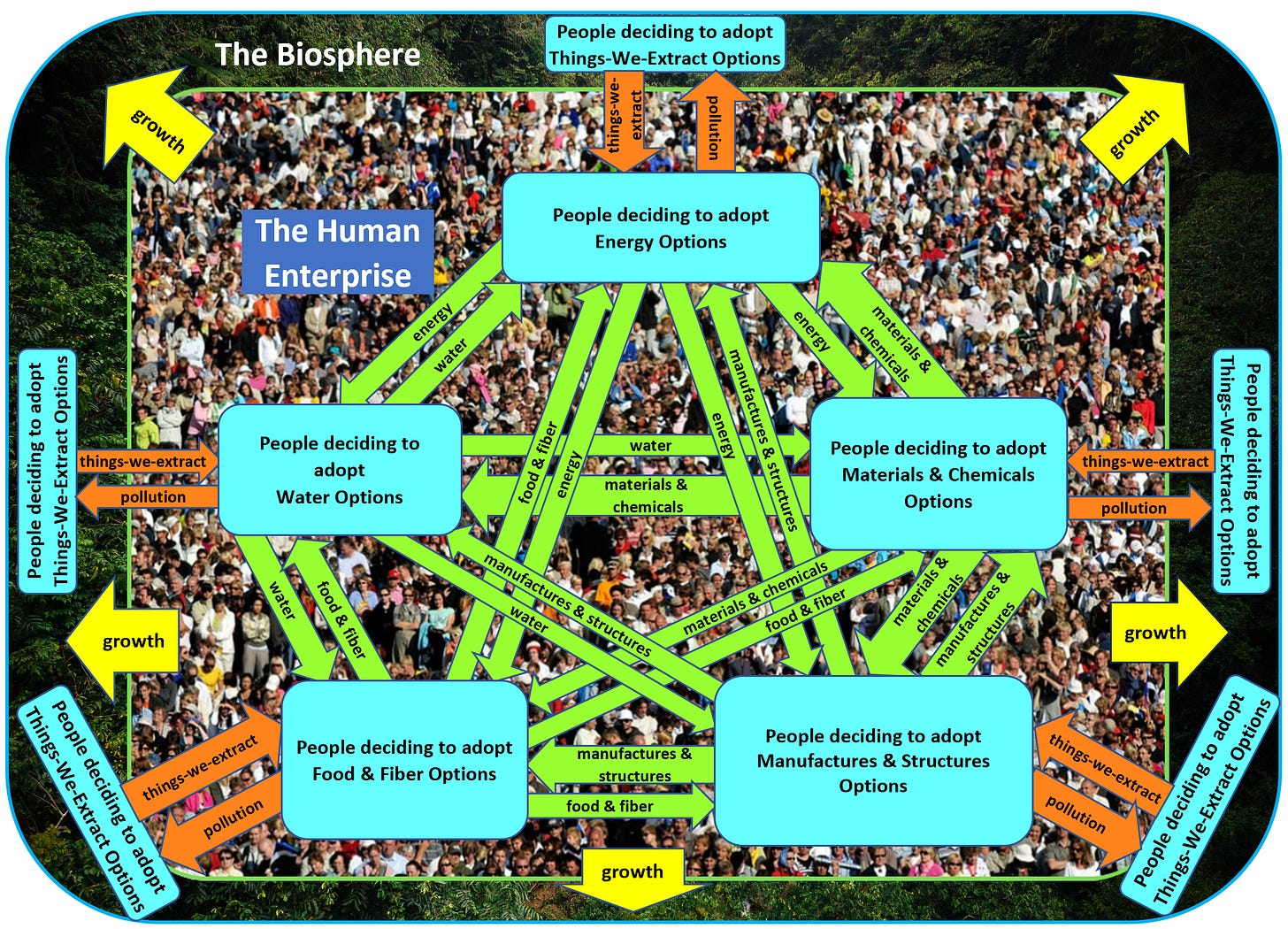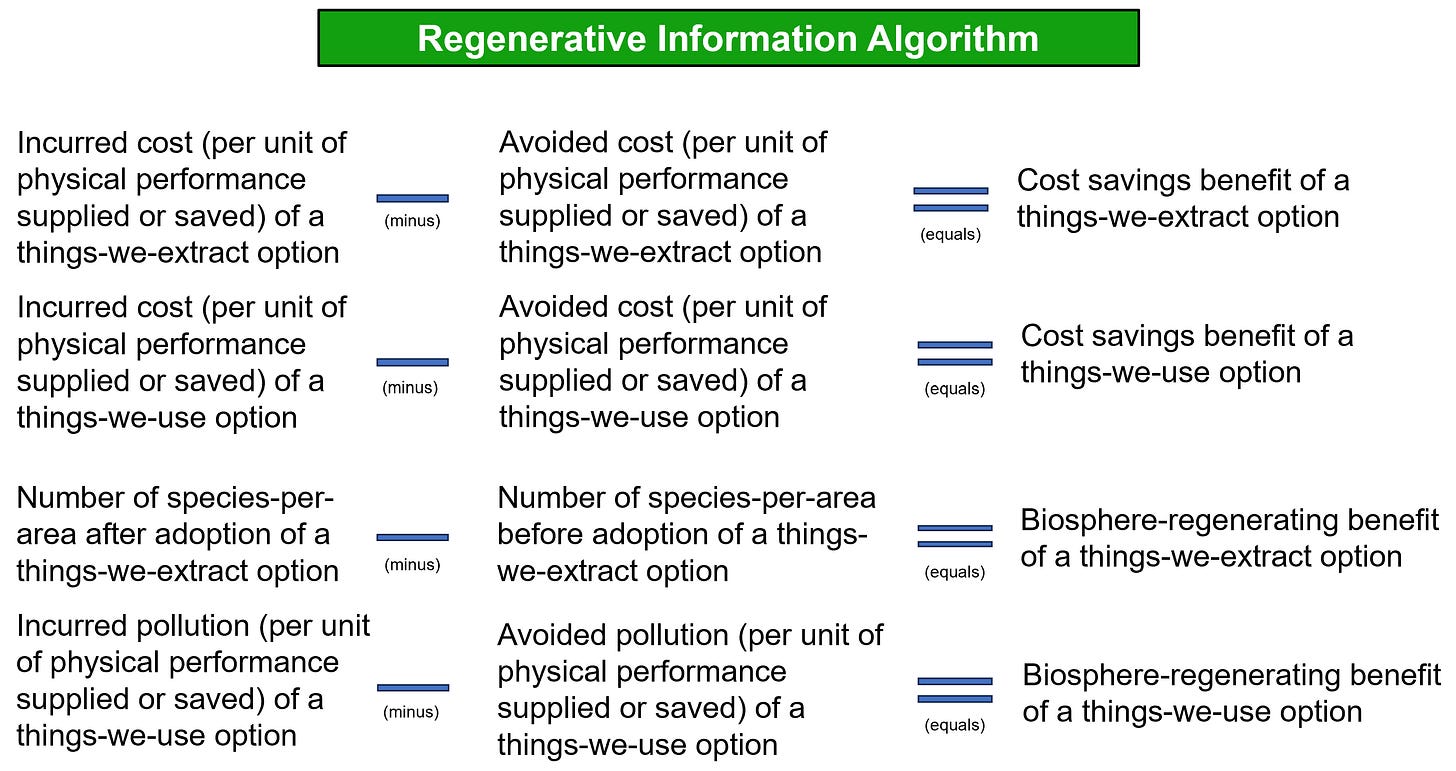Reversing the ecological crises is a simple two-step process
Using regenerative information services

Decision-making is a two-step process: first take in all the relevant information, then decide. – Ray Dalio
Human decision-making for meeting human physical needs (in turquoise) is creating exponentially growing things-we-extract flows and pollution flows (in orange) that are damaging the biosphere (in deep green) faster than the biosphere can regenerate itself …
This exponentially-growing damage to the biosphere as a whole is showing up as the nine global-scale ecological crises (including the climate crisis) identified by the Stockholm Resilience Centre …
To reverse the planet’s exponentially-growing ecological crises as a whole – and to create a “regenerative economy” on a scale of $100 trillion of avoided cost savings – I invented a simple process – called “regenerative decision-making” -- through which:
People everywhere identify options for meeting their human physical needs.
People everywhere use regenerative information services for evaluating the performance benefits, cost savings benefits and biosphere-regenerating benefits of those options …
People everywhere use regenerative information services for comparing those benefits, and …
People everywhere persuade themselves what options they want to adopt …
… and decide to adopt “regenerative options” that deliver performance benefits, cost savings benefits and biosphere-regenerating benefits[1] …
… for scaling back the things-we-extract flows & pollution flows and allowing the biosphere to regenerate itself and reverse the ecological crises as a whole …
To enable people everywhere wanting, deciding & acting to adopt regenerative options – and to create a regenerative economy on a scale of $100 trillion of avoided cost savings – I invented a new and extremely simple kind of information services – called “regenerative information services” -- in the form of:
accurate evaluations, comparisons and measurements
of performance benefits, cost savings benefits and biosphere-regenerating benefits
of things-we-extract options and things-we-use options for meeting human physical needs …
A newly-founded enterprise supplies people everywhere with regenerative information services through a simple computer-implemented application (a “regenerative information app”) that processes performance data, incurred cost data, number of species-per-area data and incurred pollution data into usable regenerative information services …
A regenerative information app uses an extremely simple algorithm (a “regenerative information algorithm”) for processing performance data, incurred cost data, number of species-per-area data and incurred pollution data into usable regenerative information services[2] …
In the words of Ray Dalio:
Decision-making is a two-step process: first take in all the relevant information, then decide.
Reversing the ecological crises is a simple two-step process through which people everywhere:
First take in all the relevant information in the form of regenerative information services,
Then decide to adopt a regenerative option.
It’s that simple.
When you commit to a seemingly-impossible goal of reversing the planet’s ecological crises as a whole, you become connected to – and get to work with -- the most successful and ambitious people in the world.
In the words of Kurt Vonnegut: “If this isn’t nice, I don’t know what is.”
Some people might feel excited to be in on the creation of a regenerative economy -- on a scale of $100 trillion -- for reversing the ecological crises (including the climate crisis) as a whole.
How about you? What’s your feeling about that?
What do you think? Does this make sense to you?
If the prospect of practically & actually reversing the ecological crises excites you,
please consider subscribing to my Substack channel, Solving the Eco-crises …
Thank you for reading Solving the Eco-crises.
Peace and Aloha!
Erik
P.S. I cross-posted this article on Medium for greater reach.
[1] The concept of “biosphere-regenerating benefits” solves the problem of “externalities” in economic decision-making:
by measuring the benefits and detriments of things-we-extract options to the biosphere’s regenerative capacity in terms of increased or decreased # of species-per-area, and not in units of money, and
by measuring the benefits and detriments of things-we-use options to the biosphere’s regenerative capacity in terms of avoided pollution and incurred pollution, and not in units of money.
[2] The “unit of physical performance supplied or saved” will depend on the nature of the things-we-extract option or things-we-use option for meeting a human physical need. For example, the “unit of physical performance supplied or saved” by an energy option for meeting a human physical need (a things-we-use option) will be a kilowatt-hour (kWh) for an electric power option and a gigajoule (GJ) for a heating or cooling option.












